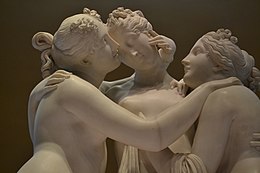Antonio Canova's Three Graces is a neoclassical marble sculpture of the three Charites of mythology, daughters of Zeus - identified in some of the engravings of the statue as, from left to right, Euphrosine, Aglaia and Thalia, embodying joy, charm and beauty respectively.
The Graces presided over banquets and meetings. As such, they were represented by artists such as Sandro Botticelli and Bertel Thorvaldsen.
A first version of the sculpture, known as the "Empressa", is kept in the Hermitage Museum; a second version, known as the "Duke of Bedfordb", is jointly owned by the Victoria and Albert Museum and the National Gallery of Scotland, where it is alternately exhibited.
The versions of The Three Graces Statue work

In 1810, Canova made a terracotta sketch in the house of Therese County Tambroni in Frascati, which he offered, probably in 1813, to Juliette Récamier who bequeathed it in 1849 to the Musée des Beaux-Arts in Lyon, where it has been kept and exhibited ever since.
In June 1812, Joséphine de Beauharnais commissioned him to paint a work on this subject.
John Russell, the 6th Duke of Bedford, during a visit to Canova's studio in Rome in 1814, was extremely impressed by the sculpture of the Graces that Canova made for Josephine. When the empress died in May of that year, he offered to buy the finished piece, but was unsuccessful as Josephine's son Eugene de Beauharnais demanded it.
Maximilian of Leuchtenberg, Eugene's son, who had moved to Russia in 1839, later had it transported to St. Petersburg where it is still on display in the Hermitage Museum.
Far from being discouraged, the Duke of Bedford commissioned another version for himself. Work on the second sculpture began in 1814 and was completed in 1817.
In 1819, it was installed in the Duke's residence at Woburn Abbey. Canova himself was in England to oversee the installation, choosing a pedestal made from a marble base with a rotating top. This work is now held jointly by the Victoria and Albert Museum and the National Gallery of Scotland, where the sculpture is exhibited alternately.
The first version, the one in the Hermitage, is carved in veined marble and has a square column behind the figure on the left (Euphrosine). The "Duke of Bedford version" is carved in white marble, has a round column, and the central figure (Aglaia) is slightly wider at the waist.
The "Duke of Bedford's version" was based on Canova's previous depictions of the Graces, including a 1799 painting, other drawings, and a bas-relief of the Graces that he executed around the same time. But it is likely that his Hermitage version and later the Duke's version are based primarily on the earlier drawings and a terracotta sketch.
We know that his model is primarily a life-size plaster group of the group now in the Canova Museum in Possagno. In the Duke of Bedford's version, the Graces are leaning on a pillar, although in earlier versions this detail is absent.
Artistic technique in The Three Graces Statue
The piece is carved from a single block of white marble. Canova's assistants roughened the marble, leaving Canova to make the final touches and shape the stone to highlight the soft skin of the Graces. This was a hallmark of the artist, and the work shows a strong allegiance to the neoclassical movement in sculpture, of which Canova is the best representative.
The three goddesses are shown naked, clutching each other, their heads almost touching, in such a way that some have considered it an erotic work. They are standing, leaning slightly inward - perhaps talking, or simply enjoying their proximity. Their hair styles are similar, braided and held at the top of their heads in a knot.

The style is elegant and suggests refinement, a delicate beauty that is common in Canova's sculpture. Art historians have often referred to the peaceful balance that seems to exist between the three heads.
Unlike the Grace compositions of antiquity, where the side figures face the viewer while the central figure embraces her friends with her back to the viewer, in Canova the figures stand side by side, facing each other.
The three female figures become one in their embrace, united by their hands and by a cloth that links them. The unity of the Graces is one of the main themes of the work. In the "Empress Josephine version" the Graces are on an altar decorated with three wreaths of flowers and a garland symbolizing their close ties.
The Three Graces Statue in Neoclassicism and Baroque
Canova's work questioned the Baroque conception of opulent beauty: he represents the Graces as slender young women.
This is not the only deviation of Canova's work from the Baroque era. For example, the Baroque works of the Italian sculptor Bernini represent a short moment in time, a snapshot.
His 1644 work, The Ecstasy of St. Teresa, shows the moment when the Holy Spirit pierces Teresa's heart, leaving her in ecstasy of the divine presence. It is a poignant scene captured by Bernini at its most intense moment.
Canova's work, however, is different. His works do not seem to possess a real sense of time, they simply exist at a moment in the past, almost a ghostly memory of mythological scenes, or of people long dead. In the case of Three Graces, he invites the viewer to do what he wants with the scene he is theatrically presenting.
This is typical of the neo-classical movement. In many ways, this work was considered a departure but is now accepted by many as a model of beauty.

